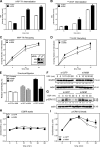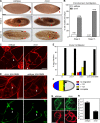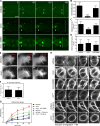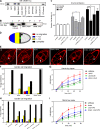I-BAR protein antagonism of endocytosis mediates directional sensing during guided cell migration
- PMID: 20385776
- PMCID: PMC2856902
- DOI: 10.1083/jcb.200910136
I-BAR protein antagonism of endocytosis mediates directional sensing during guided cell migration
Abstract
Although directed cellular migration facilitates the coordinated movement of cells during development and repair, the mechanisms regulating such migration remain poorly understood. Missing-in-metastasis (MIM) is a defining member of the inverse Bin/Amphiphysin/Rvs domain (I-BAR) subfamily of lipid binding, cytoskeletal regulators whose levels are altered in a number of cancers. Here, we provide the first genetic evidence that an I-BAR protein regulates directed cell migration in vivo. Drosophila MIM (dmim) is involved in Drosophila border cell migration, with loss of dmim function resulting in a lack of directional movement by the border cell cluster. In vivo endocytosis assays combined with genetic analyses demonstrate that the dmim product regulates directed cell movement by inhibiting endocytosis and antagonizing the activities of the CD2-associated protein/cortactin complex in these cells. These studies demonstrate that DMIM antagonizes pro-endocytic components to facilitate polarity and localized guidance cue sensing during directional cell migration.
Figures






Similar articles
-
Cell migration: MIM takes the driver's seat.Curr Biol. 2010 Jul 27;20(14):R606-8. doi: 10.1016/j.cub.2010.05.045. Curr Biol. 2010. PMID: 20656205
-
Dimerization is necessary for MIM-mediated membrane deformation and endocytosis.Biochem J. 2012 Sep 15;446(3):469-75. doi: 10.1042/BJ20120329. Biochem J. 2012. PMID: 22721729 Free PMC article.
-
Phosphatidylinositol 4,5-bisphosphate (PtdIns(4,5)P2) specifically induces membrane penetration and deformation by Bin/amphiphysin/Rvs (BAR) domains.J Biol Chem. 2012 Oct 5;287(41):34078-90. doi: 10.1074/jbc.M112.372789. Epub 2012 Aug 11. J Biol Chem. 2012. PMID: 22888025 Free PMC article.
-
BAR domain competition during directional cellular migration.Cell Cycle. 2010 Jul 1;9(13):2522-8. doi: 10.4161/cc.9.13.12123. Cell Cycle. 2010. PMID: 20581461 Free PMC article. Review.
-
Design of small molecules targeting I-BAR proteins.Curr Pharm Des. 2015;21(10):1318-26. doi: 10.2174/1381612821666141120123724. Curr Pharm Des. 2015. PMID: 25410498 Review.
Cited by
-
Missing-in-metastasis protein downregulates CXCR4 by promoting ubiquitylation and interaction with small Rab GTPases.J Cell Sci. 2017 Apr 15;130(8):1475-1485. doi: 10.1242/jcs.198937. Epub 2017 Mar 6. J Cell Sci. 2017. PMID: 28264927 Free PMC article.
-
JNK is antagonized to ensure the correct number of interommatidial cells pattern the Drosophila retina.Dev Biol. 2018 Jan 1;433(1):94-107. doi: 10.1016/j.ydbio.2017.11.002. Epub 2017 Nov 11. Dev Biol. 2018. PMID: 29133184 Free PMC article.
-
Murine missing in metastasis (MIM) mediates cell polarity and regulates the motility response to growth factors.PLoS One. 2011;6(6):e20845. doi: 10.1371/journal.pone.0020845. Epub 2011 Jun 9. PLoS One. 2011. PMID: 21695258 Free PMC article.
-
MIM and cortactin antagonism regulates ciliogenesis and hedgehog signaling.Dev Cell. 2010 Aug 17;19(2):270-83. doi: 10.1016/j.devcel.2010.07.009. Dev Cell. 2010. PMID: 20708589 Free PMC article.
-
Landscape of protein-protein interactions in Drosophila immune deficiency signaling during bacterial challenge.Proc Natl Acad Sci U S A. 2013 Jun 25;110(26):10717-22. doi: 10.1073/pnas.1304380110. Epub 2013 Jun 7. Proc Natl Acad Sci U S A. 2013. PMID: 23749869 Free PMC article.
References
Publication types
MeSH terms
Substances
Grants and funding
LinkOut - more resources
Full Text Sources
Molecular Biology Databases

